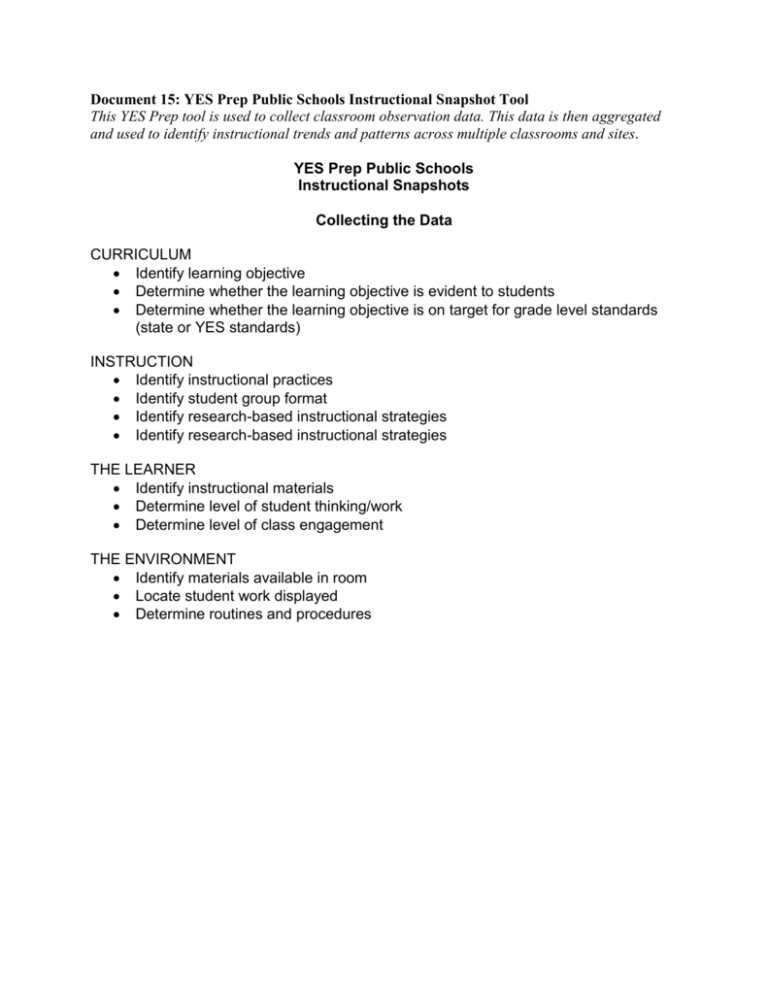Document 15: YES Prep Public Schools` Instructional Snapshot Tool
advertisement

Document 15: YES Prep Public Schools Instructional Snapshot Tool This YES Prep tool is used to collect classroom observation data. This data is then aggregated and used to identify instructional trends and patterns across multiple classrooms and sites. YES Prep Public Schools Instructional Snapshots Collecting the Data CURRICULUM Identify learning objective Determine whether the learning objective is evident to students Determine whether the learning objective is on target for grade level standards (state or YES standards) INSTRUCTION Identify instructional practices Identify student group format Identify research-based instructional strategies Identify research-based instructional strategies THE LEARNER Identify instructional materials Determine level of student thinking/work Determine level of class engagement THE ENVIRONMENT Identify materials available in room Locate student work displayed Determine routines and procedures YES Prep Public Schools Instructional Snapshots Course/Grade _____________________________Snapshot Date/Time _______ Lesson Plans Is lesson plan available? Does lesson mirror lesson plan? (optional) Team Teaching Are teachers effectively using team teaching? (Circle one.) YES YES NO NO NA NA YES NO NA Objective What is the learning objective for the lesson? (Choose one / write Summary Column Evident to students? obj.below.) Not evident to students? SWBAT… Unable to Determine On target? TEKS / District Standards Not on target? What are the TEKS / District Standards of the lesson? (Choose one from list to the right.) Unable to Determine Bloom’s Taxonomy (Choose all that apply.) High (Analysis, Synthesis, Evaluation) Evaluation: Make judgments and justify positions Synthesis: Put information together in new ways Analysis: Break down information into parts Mid (Application) Application: Use information in new ways Comprehension: Understand information Knowledge: Recall information Materials (Circle all that apply from the list below. Low (Knowledge, Comprehension) Choose one from list to the right.) 1. Textbook objects 5. Manipulatives 9. Real-world 2. Overhead / Board 6. Published Print Materials 10. Worksheet 3. Computers / Technology _________ 7. Student-created materials 11. Other 4. Video 8. Lab / Activity Effectively Supports Obj. Adequately Supports Obj. Does not support Obj. Instructional Strategies (In each of the parts A, B and C below circle all that apply.) General Instructional Practices: A B 1. Project / Lab 7. Lecture 13. Practice 2. Modeling directions 8. Teacher directed Q&A 14. Providing 3. Testing Feedback 9. Student-led 15. Objectives / 4. Centers / Stations 10. Presentation 16. Do First 5. Discussion _____________ 11. Teacher-led 17. Other 6. Re-teaching 12. Review / Closure Student Action: 1. Reading 2. Writing Research Based Instructional Practices: 1. 2. 3. 4. 5. 6. 7. 8. 9. Identifying similarities and differences Question / Advance organizers Generating / Testing hypotheses Nonlinguistic representations Summarizing / Note-taking Reinforcing effort / Recognition Homework / Practice Objectives / Feedback Cooperative learning 3. Listening 4. Talking 5. Working with handson material s C Grouping: 1. Whole Group 2. Small Group 3. Paired 4. Individual Learner Engagement (Check one.) Authentically Engaged – most students authentically engaged and self directed Authentically Engaged Highly Engaged – most students engaged, but are dependent on teacher for direction Well-Managed – student willingly compliant, ritually engaged; brought back on-task quickly Dysfunctional – many students actively reject the assigned task or substitute another activity Survey of Learning Environment (Circle all that apply.) 1. Student work displayed 4. Materials readily available 2. Rubrics displayed / used posted 5. Models / exemplars of work 3. Purposeful classroom arrangement evident 6. Routines / procedures Summary Based on the evidence, what is the likelihood that students will attain the learning objective? Highly Engaged Well-Managed Dysfunctional Effectively Supports Obj. Adequately Supports Obj. Does Not Support Obj. Highly Likely Somewhat Likely Not Likely 5. Other ________ ____






